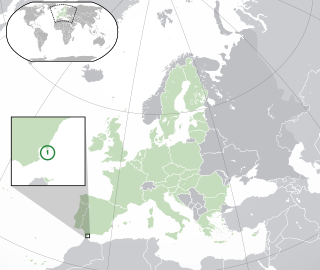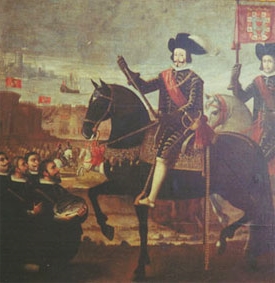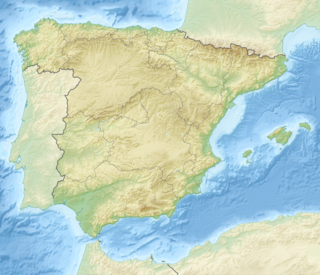External links
| General | |
|---|---|
| National libraries | |
| Other | |
| | This biographical article about a Spanish religious figure is a stub. You can help Wikipedia by expanding it. |
Pedro de Herrera was a Spanish Converso leader. He led a community of Sephardic Jews who settled for two years in the town of Gibraltar.
Herrera led a group of Jewish refugees from Córdoba in 1474. Sefardic Gibraltar was granted to them by the Dukes of Medina Sidonia. The community grew to over 4,000, who paid taxes to Medina Sidonia and established a garrison of cavalry at his command. This lasted only 2 years though. In 1476, the Duke of Medina Sidonia realigned with Spain; the Sefardim were then forced back to Córdoba, many suffering persecution for heresy by the Inquisition.
The history of Gibraltar portrays how The Rock gained an importance and a reputation far exceeding its size, influencing and shaping the people who came to reside here over the centuries.

Medina Sidonia is a city and municipality in the province of Cádiz in the autonomous community of Andalusia, southern Spain. It is considered by some to be the oldest city in Europe, used as a military defense location due to its elevated location. Locals are known as Asidonenses. The city's name comes from Medina and Sidonia, meaning "City of Sidon".

Alonso Pérez de Guzmán y de Zúñiga-Sotomayor, 7th Duke of Medina Sidonia, GE, was a Spanish aristocrat who was most noted for his role as commander of the Spanish Armada that was to attack the south of England in 1588.

Sanlúcar de Barrameda, or simply Sanlúcar, is a city in the northwest of Cádiz province, part of the autonomous community of Andalucía in southern Spain. Sanlúcar is located on the left bank at the mouth of the Guadalquivir River opposite the Doñana National Park, 52 km from the provincial capital Cádiz and 119 km from Sevilla capital of the autonomous region Andalucía. Its population is 68,656 inhabitants.

Luisa Isabel Alvarez de Toledo y Maura, 21st Duchess of Medina Sidonia, GE was the holder of the Dukedom of Medina Sidonia in Spain. She was nicknamed La Duquesa Roja or The Red Duchess due to her lifelong left-wing, anti-Francoist, pro-democracy political activism.

Alonso Pérez de Guzmán (1256–1309), known as Guzmán el Bueno, was a Spanish nobleman and hero of Spain during the medieval period, the founder of the line from which the dukes of Medina Sidonia descend.

Jimena de la Frontera is a historic town and municipality located in the province of Cádiz, Spain. According to estimates made by the National Statistics Institute of Spain (INE), the municipality has a population of 6,707 inhabitants as of 2020. The municipality contains three major towns, Jimena de la Frontera, Los Ángeles and San Pablo de Buceite. Other towns include Montenegral Alto and Marchenilla.

The history of the Jews in Gibraltar dates back more than 650 years. There have been periods of persecution, but for the most part the Jews of Gibraltar have prospered and been one of the largest religious minorities in the city, where they have made contributions to the culture, defence, and Government of Gibraltar.

Pedro Fernández de Velasco, 2nd Count of Haro was a Spanish nobleman and military figure of the last stages of the Reconquista.
Jose Alvarez or José Álvarez may refer to:
Juan Alonso de Guzmán y Suárez de Figueroa Orozco, 1st Duke of Medina Sidonia and 3rd Count de Niebla was a Spanish nobleman and military figure of the Reconquista.
Marquis of Gibraltar was a short-lived Castilian noble title (1478–1501). It belonged to the House of Medina Sidonia.

The Andalusian independentist conspiracy in 1641 was an alleged conspiracy of Andalusian nobility for Andalusia to secede from Spain. The conspiracy was brought to an end in summer 1641 after the plans of rebellion were discovered.
Don Juan Alfonso Pérez de Guzmán y Afán de Ribera, 3rd Duke of Medina Sidonia inherited the title in 1492, aged 28. In 1502, as Gibraltar was transferred to the Crown, the Marquisate of Gibraltar disappeared.

Gaspar Alfonso Pérez de Guzmán y Sandoval, 9th Duke of Medina Sidonia (1602–1664) was a Spanish nobleman who became Duke of Medina Sidonia in 1636, upon the death of Juan Manuel Pérez de Guzmán, 8th Duke of Medina Sidonia.

The history of Moorish Gibraltar began with the landing of the Muslims in Hispania and the fall of the Visigothic Kingdom of Toledo in 711 and ended with the fall of Gibraltar to Christian hands 751 years later, in 1462, with an interregnum during the early 14th century.
The ninth siege of Gibraltar was a fifteen-month-long siege of the town of Gibraltar that lasted from 1466 until 1467. The siege was conducted by Juan Alonso de Guzmán, the 1st Duke of Medina Sidonia, and resulted in a takeover of the town, then belonging to the Crown of Castile. Unlike other sieges of Gibraltar, which were the result of clashes between different powers, this was a purely internal struggle between rival Castilian factions.

The seventh siege of Gibraltar (1436) was an unsuccessful attempt by the Castillian nobleman Enrique Pérez de Guzmán, 2nd Count de Niebla to capture the stronghold of Gibraltar from the Moors. He drowned during the attempt.

The eighth siege of Gibraltar (1462) was a successful effort by soldiers of the Kingdom of Castile to take the fortified town of Gibraltar from the Moors of the Emirate of Granada. Capture of this position, which was weakly defended and was taken with little fighting, was strategically important in the final defeat of the Moors in Spain.